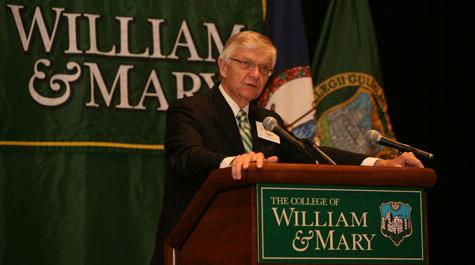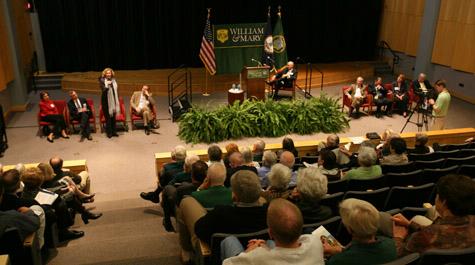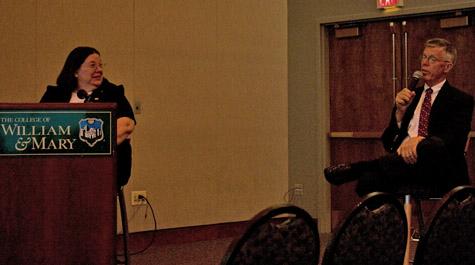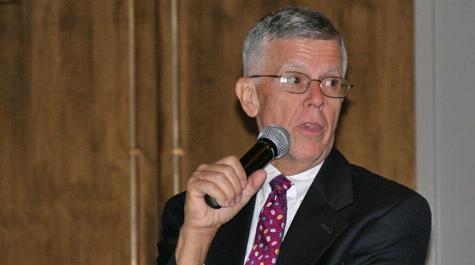Alumni take part in academic symposium
Hundreds of William and Mary alumni started Homecoming weekend by exploring their alma mater's past, present and future.
The Alumni Association hosted an academic symposium at the Sadler Center on Oct. 24, including a session that examined the College's traditions and another that featured senior administrators briefing alumni on the College's current and future goals. The symposium's two other sessions looked at politics and wealth management and estate planning.
During a panel that included President W. Taylor Reveley III, vice presidents and senior staff, Reveley told alumni that "we are doing extremely well at William and Mary right now."
He added that alumni are a key part of the College community and Homecoming weekend is an opportunity to reconnect with friends.
"It's wonderful that you have come back to the campus and that you are staying so warmly and meaningfully in touch with the alma mater," he said. "Keep doing it. I think it's good for your morale and it's certainly good for the spiritual nurture of those of us who are here every day."
Communicating more effectively with alumni is one of the priorities for the coming year, he said. Reveley used the acronym "RPFC" to describe the four special focus areas that the College is concentrating on this year: relationships, planning, finances and communication.
Finances are of particular interest to William and Mary this year in light of the recent news regarding the state budget. In response to the Commonwealth of Virginia's budget gap, Gov. Timothy M. Kaine recently announced reductions in support to state agencies, including colleges and universities. At William and Mary, those reductions total seven percent, or $3.4 million, of this year's operating budget. The state's percentage of the College's operating budget has been decreasing steadily over the past three decades. In 1980, the state's covered 40 percent of the operating budget. Today, that number is less than 20 percent, officials said.
Given the state of the economy - and all the other critical needs facing the state - Reveley said this trend in operating dollars is expected to continue.
Faced with that reality, Reveley said, the College must have a "more sophisticated, more effective development effort" and "operate as efficiently as we can.".
To help the College achieve its goals, Reveley asked the alumni to help create the notion that "giving back is a part of William and Mary" - whether donating money, networking with colleagues or even providing counsel to current students.
He also encouraged alumni to be "robustly proud" of their education.
"It's a big deal to have gone to William and Mary. We need a little less humility and a little more nice arrogance," Reveley said.
In closing, Reveley told the alumni that "when you look at the fundamentals, William and Mary is enormously strong and when you take into account history, there is no college or university in the galaxy more accustomed to and capable of surviving adversity."
Some of that history was explored in another of the symposium's sessions, "William and Mary traditions."
The session was led by Louise Kale, executive director of the historic campus, and Sam Sadler ('64, M.Ed. '71), who spent more than four decades at the College and retired this summer as vice president for student affairs.
Kale said they wanted the session to focus on events that "both celebrate and foster community."
The pair discussed various traditions at the College, from those that no longer take place - like the annual barring of professors from the College building -- to those that were established more recently, such as the senior walk that accompanies Commencement.
Using PowerPoint slides to show photos, Kale and Sadler talked about how freshmen years ago had to bow at the Lord Botetourt statue and how the Old Spotswood cannon was in working condition until, Kale said, "students who were dissatisfied with the food being served in the dining hall loaded it up with garbage, turned it around 90 degrees and shot the garbage onto the front porch (of the president's house)."
"I think you'll find that at William and Mary and probably universally at colleges, there are frequently traditions that include some sort of institutionalized mayhem," said Kale.
Sadler spoke of his many memories of the College's traditions, including the Yule Log Ceremony, Opening Convocation, the King and Queen Ball, and Commencement's senior procession across campus from the Wren Building to William and Mary Hall. The senior walk tradition was started in the mid-1970s when Commencement was moved from the Wren Building to William and Mary Hall. Sadler worked with the senior class president at the time to come up with a new tradition that would mark the special day. More than three decades later, the senior walk has become one of the most memorable experiences each year for graduating classes.
Sadler said that it isn't the traditions themselves that are special, but the memories that they create and evoke.
"Ultimately, it's not the beauty, it's not the great classes that we took, the hard work we did, the fun we had - it's the people we shared the journey with," he said. "I would say that the reason that most of these traditions are long-lasting is because all of them are reminders of the central community that exists here, which, in many ways, has only grown stronger as the years have gone by."
 Skip to main content
Skip to main content




